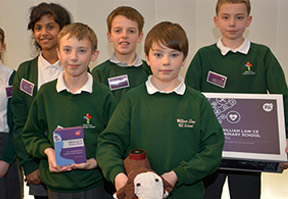Schoolchildren and undergraduates gathered on Tuesday 24 March 2015 at London’s Science Museum for the final of PA Consulting Group’s third Raspberry Pi coding competition. Twelve groups of UK-based finalists presented their inventions – which help improve people’s health and wellbeing – to a high-profile judging panel including head of Code Club Pro, Lauren Hyams; BBC technology correspondent Rory Cellan-Jones and Raspberry Pi Foundation’s director of educational development Clive Beale.
The winners
Primary school: academic years 4 – 6 William Law CE Primary School
The winning entry in the primary school category was a robotic dog that encourages children to exercise. The dog provides motivation for the child and is programmed with the following phrases: ‘keep up the pace’; ‘keep moving’ and ‘do twenty star jumps’.
Why the team won: The judges liked the concept of an animated robot dog to get children exercising. They thought that the team really knew what they were talking about, explained their invention well and created clear documentation and user guides.
Secondary school: academic years 7 – 11 The Liverpool Blue Coat School
This school created an automatic prescription dispenser that works using QR codes given to patients by their doctors. The patient simply scans the QR code on the machine which then dispenses the required prescription. The system aims to make the whole process of picking up a prescription hassle free, eliminating the need to visit a pharmacy.
Why the team won: This invention has strong benefits in saving the NHS and people both time and money. The team tackled complex technology challenges by using add-ons including a barcode scanner and camera.
Secondary school: academic years 12 – 13 Truro and Penwith College
The winners created an innovative way to control your computer. Using a small camera it can track your eye movement and consequently relay this to your computer screen. It allows the user to be able to move the mouse anywhere on the screen just by looking. The thinking behind the invention was to allow those without the ability to easily manoeuvre a mouse, to be able to use a computer more effectively.
Why the team won: This team took the Raspberry Pi to the limit of what it can achieve – and beyond. All team members showed extraordinary passion and great ambition, which came across in their presentation.
Undergraduates: University of Birmingham
Birmingham University team’s entry is a wireless, internet-connected doorbell. When your doorbell rings it can perform various actions such as calling your phone so it can be used as an intercom, text or email you with a photo of the person at the door and even tweet or live stream HD video locally on YouTube. This invention could be used in care homes or in an ill person’s home when the patient requires assistance from a nurse.
Why the team won: This product had a lot of passion behind it and tackled a serious issue. It is very well thought out and full of useful features. The product has good market potential and would be a cost-effective option compared to other home monitoring products on the market.
Anita Chandraker, head of IT delivery at PA Consulting Group and chair of the judging panel said: “This year’s finalists showed very advanced skills and it was incredible to see how teams had pushed the Raspberry Pi to its limits, fulfilling the brief in such inventive ways. The inventions were inspiring and thoughtfully designed and all of the judges agreed that many of the entries had the potential to advance into commercial products and really make a difference to everyday life.
“It was really encouraging to see the teams – especially the younger children – buzzing with excitement and exuding a natural flair for programming and engineering. We would really love to see the teams continue to build on their digital skills, creativity and team work and show other schools and universities the big things that can be achieved with such a small computer.”
The judges were: Lauren Hyams, head of Code Club Pro; Rory Cellan-Jones, BBC Technology correspondent; Clive Beale, director of Educational Development at Raspberry Pi Foundation; Richard Vaughan, times educational supplement; Samantha Atkinson, Medicines and Healthcare Products Regulatory Agency (MHRA); professor Sanjay Sharma, Department of Cardiology at St George’s University of London; Hobson Bullman, ARM, general manager – Development Solutions; Anita Chandraker, PA Consulting Group, head of IT delivery and chair of the judging panel.
Video is available here










